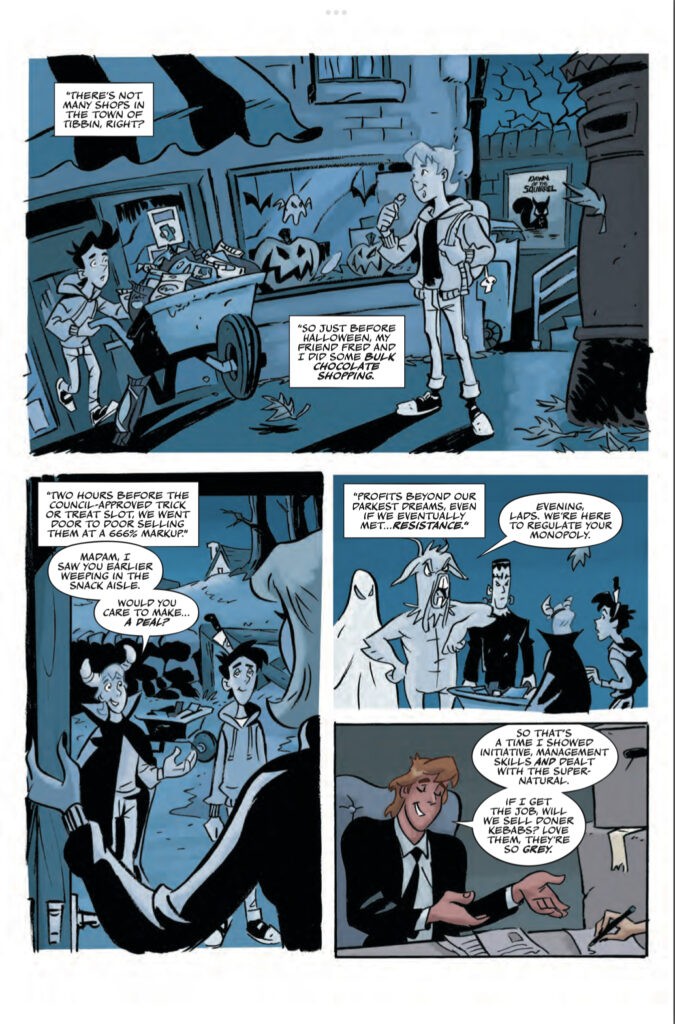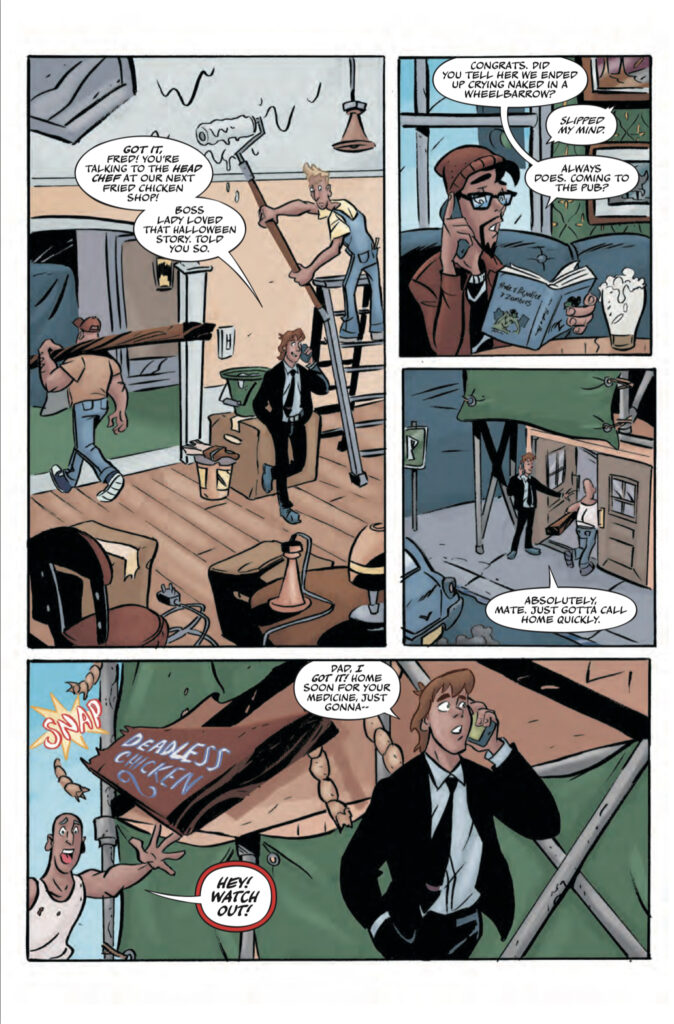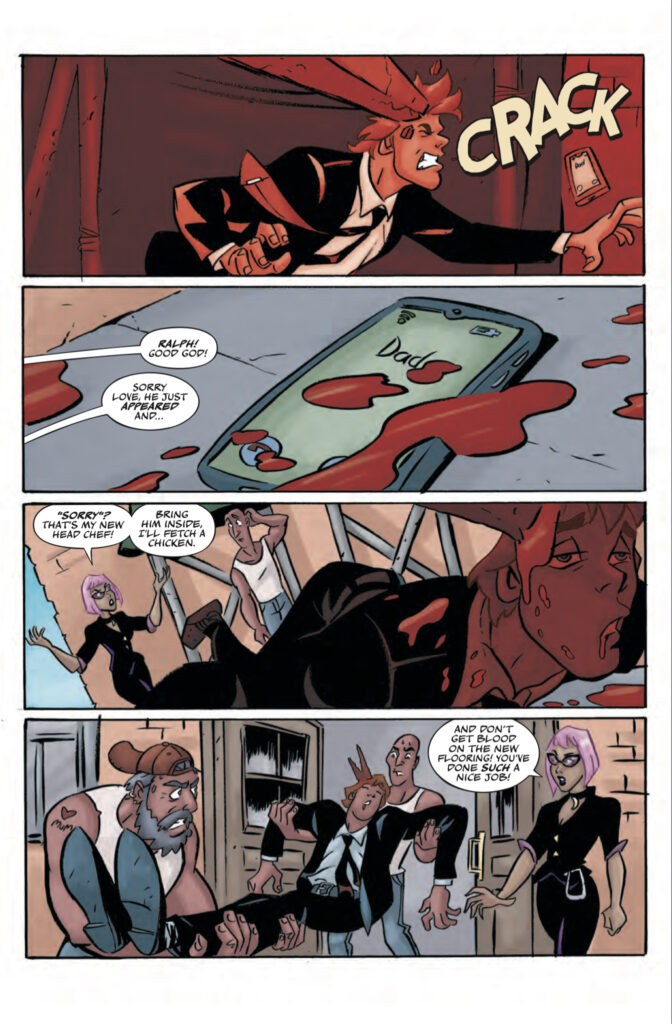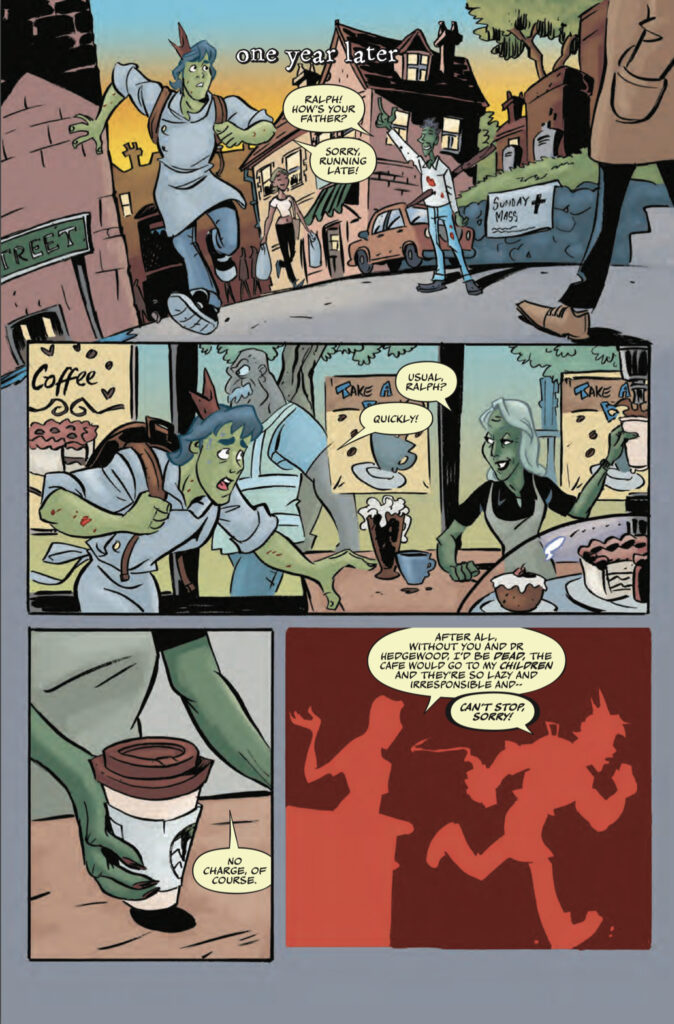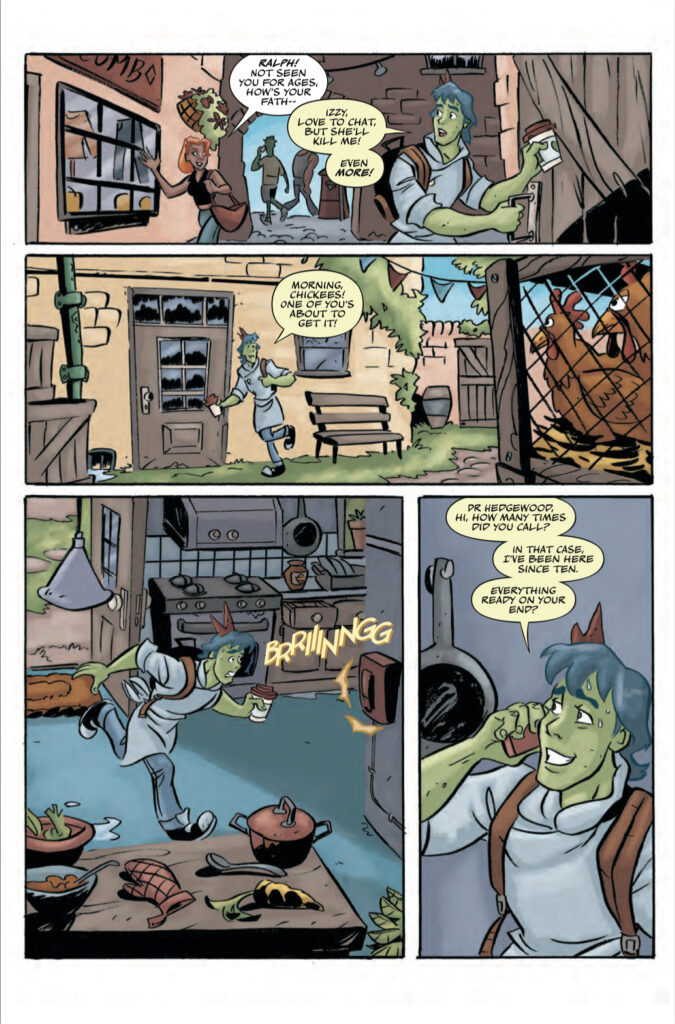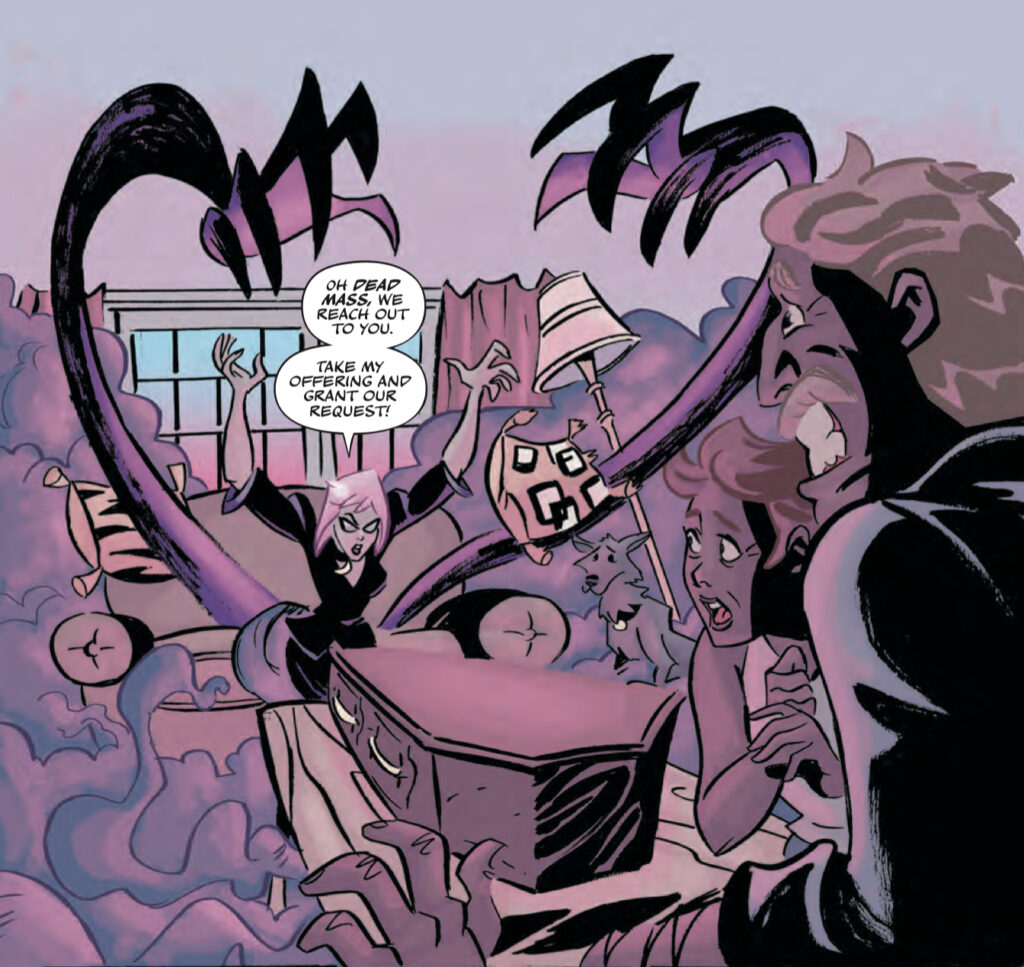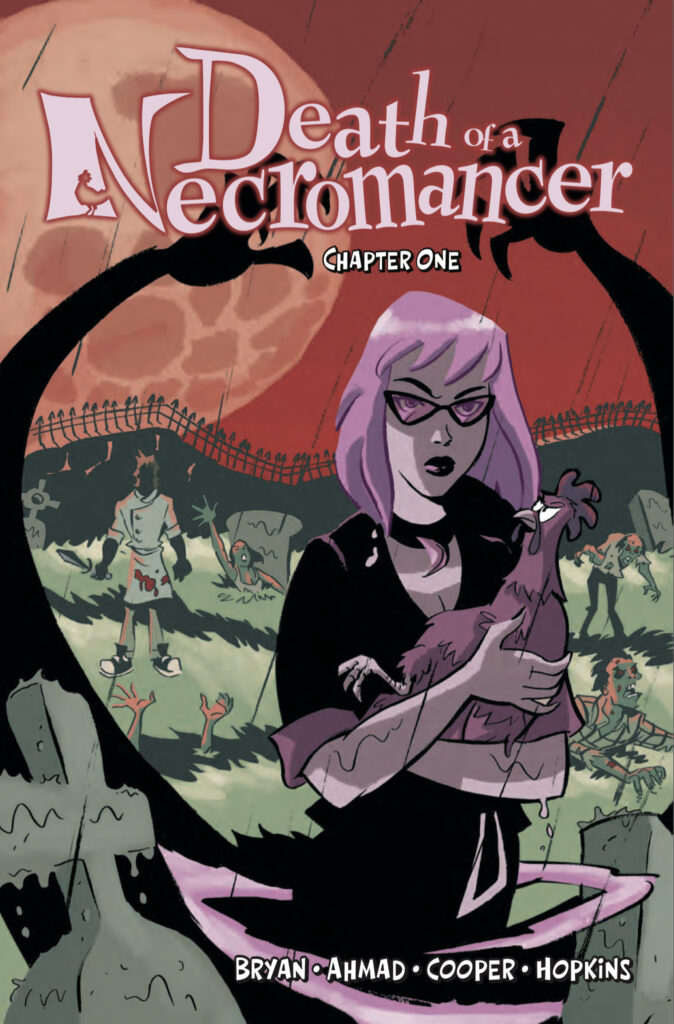
- Death of a Necromancer #1
- Written by Nick Bryan
- Illustrated by Robert Ahmad
- Colors by David Cooper
- Letters by DC Hopkins
- Now live on Kickstarter
The day he was hired as the head chef for hot new eatery, Deadless Chicken, Ralph’s life changed forever. First, immediately after leaving the interview he was killed in a tragic accident. Second, his new boss, Dr Hedgewood, wasn’t only a restaurateur but also a necromancer specializing in separating people from their deaths (we’ll explain in a minute). Third, Ralph’s job description as a fry cook (Wait… isn’t he dead? Just hang on and we’ll explain) broadened to include the duties of necromantic assistant. Now, when Dr Hedgewood takes a job to reunite families with their dearly departed, Ralph kills a chicken so she can substitute its death to satisfy the Dead Mass (I said we’d explain… take a breath).
Okay, here it is as I understand it… I think.
In the world of Death of a Necromancer, “death” isn’t just the end of life. Rather than something that happens to a person, death is the spirit that follows them throughout their life until the end when it’s returned to the Dead Mass. There, it waits for its next go around in the eternal cycle. Think about it. Without death, there wouldn’t be a true sense of the finite. No consequence. Death is the voice that whispers in your ear, encouraging you to do what’s right, reminding you to make the most of the time you have. In Dr Hedgewood’s words, “We’re not reversing death. We’re… separating people from it.” But the Dead Mass always takes its due, so the necromancer uses the life of a chicken as a substitute for the person she’s looking to return to the world.
A little clearer? I hope so, because I read through Death of a Necromancer twice to get a handle on it… maybe.
Nick Bryan has a gift for taking a concept… in this case professional necromancy as a way to keep families in touch… and wringing it for all its worth. The first time I read one of his comics, the near-perfectly crafted one-shot … And it Snowed, turned out to be the happiest of accidents as it was included in a stack of indies I was buying by way of support during the initial covid shutdown. It’s an excellent example of the comicbook short story, providing a fast-paced narrative that did a lot of heavy lifting: characters were introduced, mythology was established, stakes were set, and a satisfying resolution was reached. In Death of a Necromancer, Bryan is taking on a heavier workload as he dips into themes that have eluded philosophers for centuries: What is death? Is it to be feared? Is it to be avoided? Is death, morbid as it may sound at first, the constant companion that reminds us of who we are and where we’re going? In this story, Bryan is suggesting that death is more like a conscience, telling us when we might be going off the path and suggesting that maybe a little more care should be taken. Whether that means “I need to call my mom” or “hey, idiot, sledding off the garage roof is a dumb idea”, it’s not a morbid concept at all. In Bryan’s story it’s a matter of perspective.
My other favorite thing about Death of a Necromancer is that it carries the artwork of Robert Ahmad, who also corroborated with Nick Bryan on … And it Snowed and was another highlight on that comic. Ahmad’s work carries a little bit of Disney animation, and although I try to stay away from specific comparisons he’s got a little Bruce Tim in his corner. His illustrations take what could be a very heavy topic (talking about death here) and makes it a little lighter without sacrificing detail or composition. In his characters, Ahmad can portray mood and personality with clean and simple lines. With the right touch of exaggeration, he shows all the action in a single panel without over-crowding it. You might look at his style and think it’d be more suited to a title aimed at a younger audience, but I think his approach works on different levels and shouldn’t be limited.
The colors by David Cooper reinforce that fine work with a bright color set, fleshing out the world and adding depth, taking another step away from the doom & gloom implied by this one’s title. With a different approach and a grimmer palette, Cooper could’ve turned the look of this book into a completely different thing, and it wouldn’t have worked so well with Nick Bryan’s narrative.
Also in sync with the story being told, DC Hopkins’ letters stay with the curve. The dialogue never interferes with the story by blocking off the action or forcing a pause to decipher in what direction it needs to be read, and Hopkins doesn’t try to puff his work up with unnecessary flair. That all sounds pretty simple, but believe me it’s not. A letterer has to collaborate with writer & artist(s), taking cues from their intent and using the space in a panel for best effect. If you’ve never come across a case of bad lettering, consider yourself lucky because I’ve come across near migraine inducing examples of letters gone wrong.
Death of a Necromancer is a dense story, and the first issue is laying out a LOT of groundwork as magic is defined & explored along with the consequences of its use. Being more familiar with Nick Bryan’s work in comic one-shots, it’s great to see that he’s carrying his idea of tight storytelling into the longer form of multiple issues. Some of the concepts might have been introduced and explained more slowly over the course of the issue, smaller bites to make it easier to take in. But, by the end of my second read through I think I’d built up a strong appreciation for what this team is trying to build and a second run at this one wasn’t painful in the least.
Maybe it just means that I need to slow down… listen to my death when he tells me to take my time, enjoy the journey… something like that.
Final Score: 11/13
